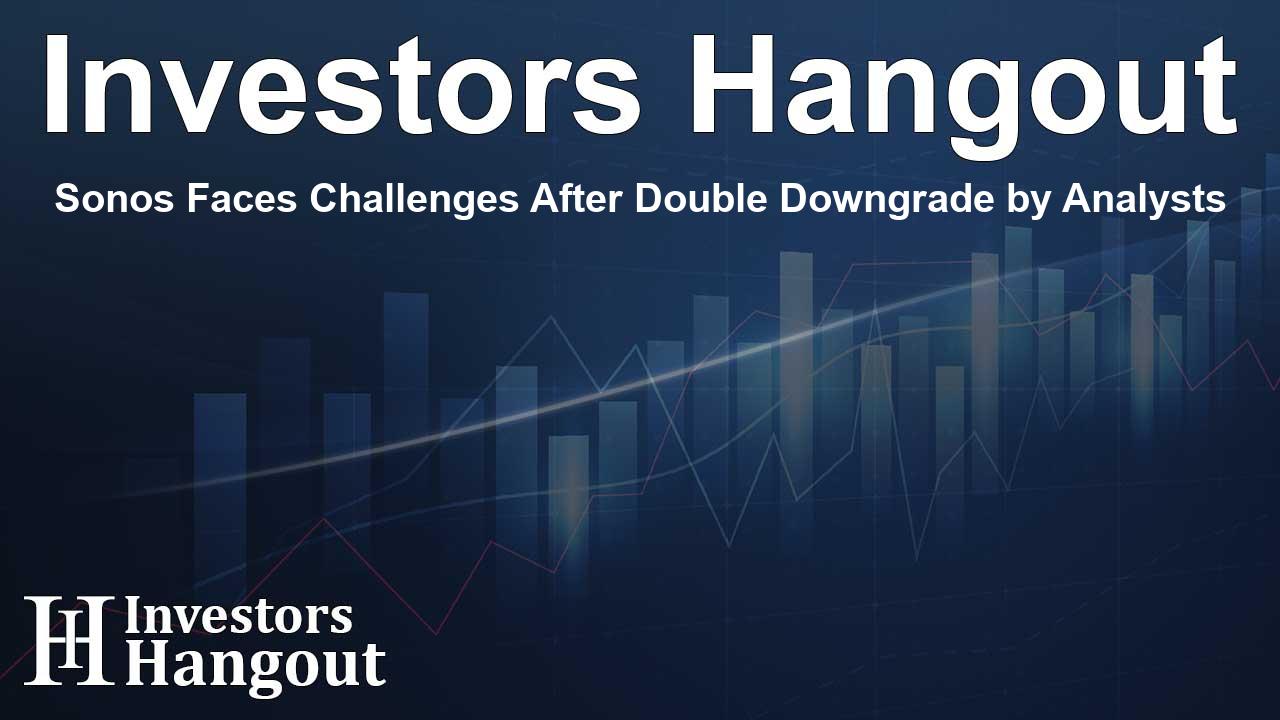Sonos Faces Challenges After Double Downgrade by Analysts

Sonos Experiences Setbacks Following Analyst Downgrade
Sonos has recently found itself in the spotlight as analysts from Morgan Stanley have issued a double downgrade of the company's shares (NASDAQ: SONO). This downgrade marks a significant shift, reducing the rating from Overweight to Underweight, thus raising concerns among investors.
Impact of App Redesign on Financial Performance
The downgrade comes on the heels of an assessment that the effects of Sonos's recent app redesign are more adverse than previously anticipated. Analysts have expressed that their forecasts for fiscal year 2025 reveal revenue and adjusted EBITDA will fall approximately 5% and 13% lower than the consensus estimates. This unexpected revelation has raised eyebrows regarding the company's future financial health.
New Price Target Set by Analysts
In conjunction with the rating drop, Morgan Stanley has also slashed its price target for Sonos stock from $25 down to just $11. This drastic change highlights the seriousness with which analysts view the challenges plaguing Sonos at the moment.
Market Reaction to Analyst Insights
The immediate reaction in the stock market was evident, as Sonos shares dropped more than 6% in premarket trading following the downgrade announcement. The company's previous efforts to enhance user experience with the overhauled app, launched in early May 2024, have seemingly backfired. This redesign aimed to provide a more seamless experience but faced backlash from existing users, prompting an apology from the CEO.
Revised Revenue Guidance and Future Implications
In light of these developments, Sonos has already revised its revenue guidance for the upcoming September quarter by a staggering 40%. This guidance adjustment, along with the analysts' downward revisions for the fiscal years 2025 and 2026, raises significant questions about the company's resilience and ability to recover.
Divergence Between Valuation and Fundamentals
Interestingly enough, amidst these setbacks, Sonos shares have still managed to rise in line with the broader market, despite the analysts believing that the current valuation is unjustified. The analysts argue that the gap between Sonos's valuation and its underlying fundamentals is not sustainable, as new data on customer sentiment indicates potential long-term challenges.
Long-term Customer Retention Risks
One of Sonos's strengths historically lies in its capability to attract and retain customers through an engaging ecosystem, enabling repeat purchases and word-of-mouth referrals. However, Morgan Stanley has indicated that this positive growth model is now at risk, given the current negative sentiment among users. As a stark reminder, these users represent around 44% of annual Sonos registrations, indicating that their feedback significantly influences the company's trajectory.
Concerns over Product Performance and Market Dynamics
The analysts have raised alarms about potential near-to-medium-term challenges that Sonos may face, as the recent performance of its new product, Sonos Ace, has not met expectations. Along with this, the audio market continues to exhibit weaknesses, contributing further to the bleak outlook for the company.
Declining Engagement and Growth Rates
App engagement levels have reportedly dropped to pre-COVID benchmarks, highlighting a concerning downward trend. Moreover, new user growth has declined by 9% year-over-year, indicating that the growth momentum is faltering. With upcoming product launches not likely to significantly impact the market, analysts suggest that achieving consistent revenue and EBITDA growth in the near term will be increasingly troublesome.
Conclusion: Navigating Uncertain Waters Ahead
Clearly, Sonos is navigating a challenging landscape as it grapples with feedback from users and fluctuations in market performance. Analysts are closely monitoring these developments, and the coming months will be crucial in determining whether Sonos can rebound from these setbacks or if more profound changes are required to adjust to the current dynamics of the audio market.
Frequently Asked Questions
What led to Morgan Stanley's downgrade of Sonos?
Morgan Stanley downgraded Sonos due to greater-than-anticipated negative impacts from its app redesign on financial performance.
What is the new price target for Sonos shares?
The new price target set by Morgan Stanley for Sonos shares is $11, significantly reduced from the previous target of $25.
How have Sonos shares reacted to the downgrade?
Sonos shares fell more than 6% in premarket trading following the downgrade announcement by Morgan Stanley.
What challenges is Sonos currently facing?
Sonos is facing challenges such as declining app engagement, negative customer sentiment, and difficulties with new product launches.
What is the outlook for Sonos in the near future?
The outlook for Sonos appears challenging, with analysts expecting difficulties in achieving consistent revenue and EBITDA growth.
About The Author
Contact Olivia Taylor privately here. Or send an email with ATTN: Olivia Taylor as the subject to contact@investorshangout.com.
About Investors Hangout
Investors Hangout is a leading online stock forum for financial discussion and learning, offering a wide range of free tools and resources. It draws in traders of all levels, who exchange market knowledge, investigate trading tactics, and keep an eye on industry developments in real time. Featuring financial articles, stock message boards, quotes, charts, company profiles, and live news updates. Through cooperative learning and a wealth of informational resources, it helps users from novices creating their first portfolios to experts honing their techniques. Join Investors Hangout today: https://investorshangout.com/
The content of this article is based on factual, publicly available information and does not represent legal, financial, or investment advice. Investors Hangout does not offer financial advice, and the author is not a licensed financial advisor. Consult a qualified advisor before making any financial or investment decisions based on this article. This article should not be considered advice to purchase, sell, or hold any securities or other investments. If any of the material provided here is inaccurate, please contact us for corrections.
